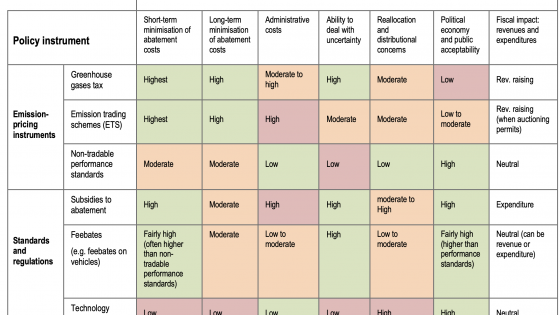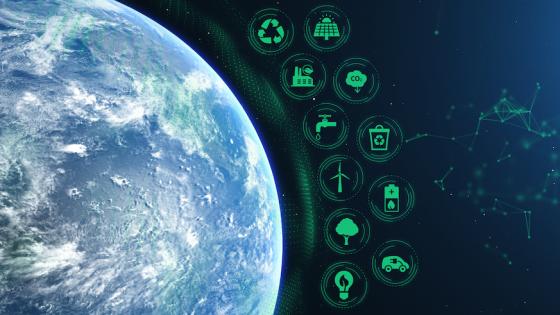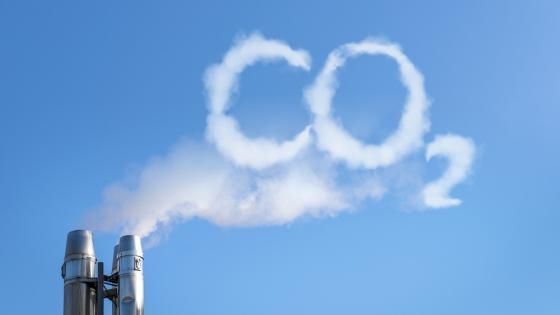Is economic growth possible in a world with environmental constraints? More than 50 years ago, this question was posed by Donella Meadows and her colleagues in a 1971 report to the Club of Rome, The Limits to Growth. At the time, their book was attacked and even ridiculed by growth theorists for its lack of economic foundations. Predictions made in the 1970s about global warming as a consequence of CO2 emissions (see Nordhaus 1977) look remarkably accurate a half-century later, raising questions once again about the premise of unbounded economic growth.
To avert the threat of extreme climate outcomes posed by anthropogenic climate change, net global greenhouse gas emissions must fall to zero. A consensus is emerging that the projected pace of emissions reduction is too slow to achieve this goal. As a result, it will be necessary to recapture (sequester) greenhouse gases at scale, for example by direct air capture or large-scale reforestation (IPCC 2022). Since there are few incentives for private firms to operate these abatement technologies voluntarily in a free market, governments will most likely be expected to ensure that the necessary level of sequestration is undertaken. As CO2 removal is a public good, this effort could rationalise massive government spending and taxation. Alternatively, governments could mandate private firms to undertake abatement and bear the costs through ‘smart policies’ such as carbon shares (Lemoine 2021). In either case, capital and labour must be diverted to the abatement of greenhouse gases and away from other productive uses. In a strict material sense, abatement makes us poorer.
The size of this problem is unclear. Abatement technologies, particularly sequestration, are currently costly, and the potential for future improvements and scalability is uncertain (Realmonte et al. 2019). If an efficient technology is developed within the next few decades, sequestering the necessary amount of greenhouse gases could be done at little cost. If, on the other hand, progress in these technologies is slow, the resource cost of abatement might be very large. This poses a number of questions for the global economy. Under what conditions is long-run material economic growth still possible? How does abatement change the structure of our economies? What is the role of government, given that abatement technologies must be deployed at large scale?
In our paper (Burda and Zessner-Spitzenberg 2022), we examine these questions through the lens of basic neoclassical growth theory (Solow 1956, Swan 1956) augmented by environmental constraints (Stokey 1998, Brock and Taylor 2010, Dasgupta 2021). The production of material output and CO2 abatement are two distinct economic sectors which compete for labour and capital. Both technologies are likely to improve over time due to technical progress, although the rates of progress might differ. Greenhouse gas emissions occur in the production of material output and cannot be avoided completely. But over time, emissions per unit of material output decline as the economy transitions towards renewable energy sources and energy efficiency improves. The impact of CO2 abatement on the prospects for future economic growth will be determined by two factors: the amount of CO2 that must be recaptured and the efficiency of the technology used.
The first factor depends on the rate at which the CO2 intensity of output declines, preventing the cumulative amount of greenhouse gases from reaching critical levels associated with catastrophic climate damage (Dasgupta 2021). Current projections show that advanced economies will exhaust their remaining carbon budgets for the 1.5°C targets before 2050 (IPCC 2022). If Paris Agreement limits and the associated carbon budget are to be met, it will be necessary to offset additional greenhouse gas emissions through abatement. In this case, the second factor – the efficiency of abatement technologies – will become the key determinant of growth dynamics. The less efficient abatement is, the more intensively production factors must to be devoted to it. In the short run, the shift of capital and labour away from production reduces material wealth, as measured by resources available for consumption and investment. In the long run, the possibility for growth in production volumes depends on the rate of technical progress in abatement.
Figure 1 Stylised growth paths for benign and adverse scenarios
Notes: The figure shows stylised growth paths for two scenarios. In the benign scenario (blue solid line), abatement technologies progress quickly. A contraction in output occurs when the carbon budget is exhausted and resources are diverted towards abatement. In the long run, the economy recovers to its previous growth path. In the adverse scenario (red dashed line), progress in abatement is slow. A larger contraction in output occurs and material growth slows down permanently.
We show how the rate of technical progress in abatement technologies shapes the future economic growth path in an economy in which abatement is provided as a pure public good. Two scenarios emerge. In a benign scenario, this rate is sufficiently high and the questions posed above have simple answers: In the long-run, the upper bound on greenhouse gas emissions does not affect the nature of economic growth, the structure of the economy, or the relative size of government. We can simply outgrow environmental constraints by becoming more efficient in abatement without any lasting consequences. In the adverse scenario, the rate of progress in abatement lies below a critical threshold, limits to growth emerge, and the answers to our questions become more nuanced. Figure 1 shows stylised growth paths for material production in the two scenarios.
First, long-run growth in material production and consumption remains possible as long as emissions per unit of output decline (decarbonisation) or if sustained technical progress in abatement is possible. If there is no improvement in either process, growth in material output will cease. This result echoes the pessimistic conclusion of Dasgupta (2021) that a limit to mitigating the environmental impact of economic activity makes indefinite growth on a finite planet impossible. A more likely scenario is that progress in abatement technologies is positive. Material growth will slow down, but does not cease.
Second, the necessary abatement of CO2 emissions causes permanent and continuous structural change. Dynamics in relative prices and production patterns emerge that are familiar from Baumol’s (1967) famous “service disease”. The same logic that Baumol developed for the service sector applies to the abatement of CO2. In a sector with a slow rate of technical progress, production costs rise secularly over time as productivity in other sectors drives economy-wide wages higher. Moreover, if the economy cannot substitute away from this sector, it absorbs an ever-increasing share of production factors. Stagnation in the sector thus slows the overall growth rate of the economy.
Third, as the share of production factors diverted to CO2 abatement grows and the production of the public good increases, the size of government must also increase. This has important consequences for the measurement of GDP. If abatement is produced or purchased by the government, it enters GDP as government consumption at factor cost. The rising cost of abatement thus drives up the growth rate of measured GDP. Alternatively, if abatement is mandated by direct regulation, it must be purchased by private firms as an intermediate input to production. Abatement does not enter GDP directly in this case, necessarily implying a lower measured growth rate.
By restricting differences in traditional goods production and abatement sectors, we intentionally highlight the central role played by technical progress in such sectors for economic dynamics. If large-scale sequestration of CO2 is necessary for reaching climate goals set out by the Intergovernmental Panel on Climate Change (IPCC), it will be imperative to invest resources in stimulating productivity of these technologies. Our analysis shows that the pace of technical progress in abatement is decisive for sustainable improvements in long-run material standards of living. If growth in sequestration productivity remains modest, we can expect durable ‘greenflation’ – the rising costs of goods in terms of labour and capital – and modest rates of per capita output and consumption growth. Under the worst scenarios, the dire forecasts of the Club of Rome could become reality.
References
Baumol, W J (1967), “Macroeconomics of Unbalanced Growth: The Anatomy of Urban Crisis”, American Economic Review 57(3): 415–426.
Brock, W A and S M Taylor (2010), “The Green Solow Model”, Journal of Economic Growth 15(2): 127–153.
Burda, M C and L Zessner-Spitzenberg (2022), “Greenhouse Gas Mitigation and Price-driven Growth in a Baumol-Solow-Swan Economy”, CEPR Discussion Paper 17368.
Dasgupta, P (2021), The Economics of Biodiversity: The Dasgupta Review, HM Treasury.
IPCC (2022) Climate Change 2022: Mitigation of Climate Change.
Lemoine, D (2021), “A policy framework for achieving negative emissions”, VoxEU.org, 28 July.
Phelps, E (1961), “The Golden Rule of Capital Accumulation: a Fable for Growthmen”, American Economic Review 51(4): 638–643.
Realmonte, G, L Drouet, A Gambhir, J Glynn, A Hawkes, A C Köberle and M Tavoni (2019), “An Inter-Model Assessment of the Role of Direct Air Capture in Deep Mitigation Pathways”, Nature Communications 10(1): 1–12.
Solow, R M (1956), “A Contribution to the Theory of Economic Growth”, The Quarterly Journal of Economics 70(1): 65–94.
Stokey, N L (1998), “Are there Limits to Growth?", International Economic Review 39(1): 1–31.
Swan, T W (1956), “Economic Growth and Capital Accumulation”, Economic Record 32(2): 334–361.




